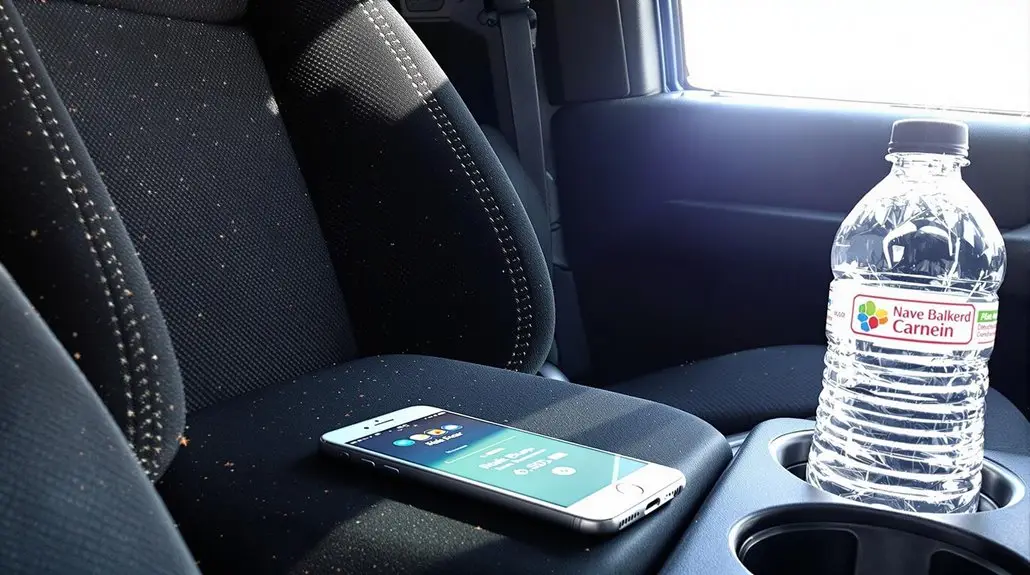If you’re using rideshare services, knowing how to spot and prevent bed bugs in cars is essential for your protection. These pests can hide in seams and crevices of vehicles, just as they do in homes. Look for dark spots or blood stains on upholstery, which can indicate an infestation. Drivers need to conduct regular inspections to keep their vehicles clean and secure. Remember, both cleanliness and quick action are key to preventing these pests from spreading. Curious about some effective inspection techniques and pest control strategies? There’s more to uncover that can keep you bug-free on your rides.
Key Insights
- Bed bugs can infest vehicles just like homes, often hiding in seams, upholstery, and storage areas.
- Regular inspections of your vehicle for dark spots, blood stains, and exoskeletons are essential to prevent infestations.
- Utilize heat treatments and deep cleaning methods to eliminate bed bugs if found in your vehicle.
- Promptly report any signs of bed bugs to authorities and fellow rideshare drivers to maintain community safety.
- Maintaining cleanliness and decluttering your vehicle can significantly reduce the risk of bed bug infestations.
Bed Bug Infestations Overview
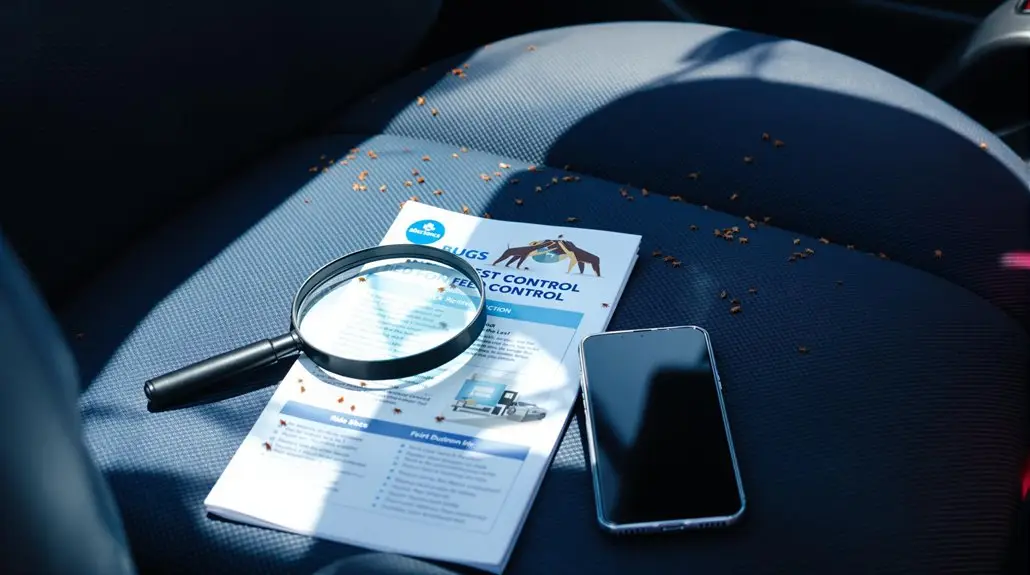
Bed bug infestations have become a pressing concern for many Americans, with one in five people either experiencing an infestation or knowing someone who has. These bothersome critters thrive in urban areas, where they’re three times more prevalent than in rural settings. If you live in a city, especially in a rental, you’re more likely to encounter these unwelcome guests.
Bites are the most common sign of a bed bug infestation, often appearing in clusters or rows on your skin. While it’s easy to dismiss a few bites, you mightn’t realize that reactions can take a couple of days to show up, leading to delayed action. Imagine the anxiety that creeps in as you wonder if those itchy welts are something more serious. In fact, bed bug complaints peak during the summer months due to increased travel, making vigilance even more crucial.
The impact of bed bugs goes beyond the physical. Many people report feeling anxious, stressed, or even depressed after discovering an infestation. You might hesitate to invite friends over or even avoid traveling due to the fear of bringing these bugs back home.
Bed bugs can hide in surprising places like stuffed animals or bedside lamps, making them difficult to detect. They can live for months without feeding, so even if you think you’re in the clear, they could still be lurking around.
With treatment costs ranging from $1,750 to $5,000, it’s essential to be aware of the risks and take proactive steps to protect your space and your peace of mind.
Common Locations for Bed Bugs
Understanding where bed bugs commonly hide is essential for effective prevention and control. These bothersome pests can easily infiltrate your home, making it important to know their favorite spots.
In your living space, check mattresses and box springs, especially in those folded areas. Bed frames and headboards often harbor them in their cracks and crevices, while baseboards and even behind wallpaper can be hiding spots. You might find them lurking in electrical outlets or wall voids, and don’t forget to inspect the seams and cushions of your upholstery.
When you venture into public spaces, be aware that hotels and motels are notorious for infestations—68% of pest professionals report this. Nursing homes and hospitals aren’t far behind, with 59% noting issues there. Bed bugs are also frequently encountered on public transportation, like buses and trains, which can also be a risk, as can libraries and schools, which have a reported infestation rate of 47%.
Other locations to take into account include laundromats, particularly around shared folding tables and high-heat dryers. Office buildings and college dorms are also common culprits, with 46% and 45% of pest professionals reporting infestations, respectively.
Retail spaces and movie theaters can harbor these unwelcome guests too.
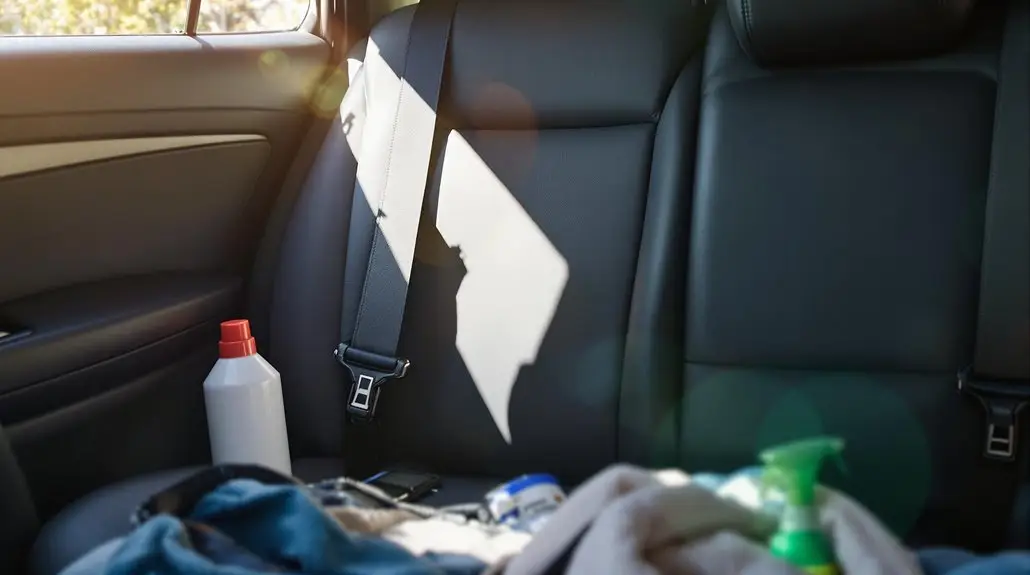
As a rideshare driver, maintaining your vehicle is vital for passenger security and comfort. Regular inspections can help you catch any potential issues, including signs of bed bug infestations. If you do discover a problem, following effective treatment protocols is necessary to guarantee a clean and welcoming environment for your riders. Additionally, ensuring passengers are dropped off in safe locations is crucial to avoid any potential risks associated with rideshare services.
Vehicle Maintenance Importance
Maintaining your vehicle is vital for rideshare drivers, not just for protection but also for providing a comfortable experience for passengers. A well-maintained car reflects your commitment to service and guarantees your riders feel valued.
Following the manufacturer’s routine maintenance schedule, like oil changes every 5,000 to 7,500 miles, keeps your engine running smoothly. Regularly check and maintain brake fluid levels and inspect your brakes for any unusual noises. Additionally, consistent upkeep ensures smooth operation and reliability, which is crucial for a positive ride experience.
Tire maintenance is essential too—rotate them every 6,000 miles and verify proper tire pressure to avoid accidents. Address punctures or wear promptly, as security is paramount.
Also, don’t overlook the comfort aspect: vacuum your car regularly and keep high-touch areas clean. A functioning AC and heating system enhances passenger satisfaction.
Lastly, use a maintenance log to track all activities and repairs. By prioritizing vehicle maintenance, you not only protect yourself but also create a welcoming environment that passengers will appreciate.
Your efforts will make them feel at home in your car, fostering a sense of belonging with every ride.
Regular Inspections Required
Regular inspections for bed bugs are a vital responsibility for rideshare drivers, especially when your vehicle frequently carries different passengers. To protect yourself and your riders, make it a habit to inspect your vehicle regularly. If you’ve had reports of bed bugs or noticed suspicious bites, it’s important to conduct an inspection right away.
Incorporate these checks into your routine vehicle maintenance schedule. If you’re driving in an area known for infestations, or if you’ve had bed bugs in your home, consider inspecting weekly or bi-weekly. Additionally, understanding that landlords must maintain habitable conditions can motivate drivers to ensure their vehicles are pest-free. Be aware that common pests in Florida can easily transfer from one location to another.
Focus on areas like under the seats, in the glove compartment, and along the seams of your car seats. Don’t forget about the trunk and cargo areas. Look for dark spots, blood stains, or exoskeletons, and use flashlights to illuminate hidden spaces.
Document your findings, keeping a log of inspection dates and results. If you find any signs of bed bugs, report it to the appropriate authorities and inform fellow drivers or passengers.
Building a community of awareness helps everyone feel more secure while using rideshare services. Regular inspections foster a welcoming environment for all.
Treatment Protocols for Infestations
Taking swift action is essential when dealing with bed bug infestations in your rideshare vehicle. If you suspect an infestation, start by inspecting the car for reddish-brown blood spots, small blood smears, or a musty odor. Look under seats, in glove compartments, and along seams for bugs themselves or their feces.
Once confirmed, you’ve got a few treatment options. Heat treatment is highly effective—this method raises the interior temperature above 130 degrees for several hours, ensuring thorough elimination. You might also consider the tenting method, heating the vehicle to lethal levels for bed bugs. It’s important to note that bed bugs spread rapidly, which can lead to larger infestations if not addressed promptly.
While liquid pesticide sprays are cheaper, they often don’t eliminate infestations completely.
Don’t forget to clean your car regularly and remove clutter to prevent future outbreaks. If you suspect exposure from passengers, encourage them to wash their clothes and shower after the ride.
Cleaning and Maintenance Tips
To keep your rideshare vehicle free from bed bugs, regular inspections are key. You should focus on deep cleaning techniques and implement effective pest control strategies to minimize risks. Bed bugs utilize backpacks, coats, and luggage for transport, making it essential for drivers to be proactive in checking their vehicles.
Regular Vehicle Inspections
Making certain your vehicle is in top shape is essential for passing inspections and providing a secure rideshare experience. Regular inspections not only keep you compliant but also help you create a protected environment for your passengers. Here are three key areas you should focus on:
- Lights: Make sure all headlights, tail-lights, and turn indicators are functioning properly. Dim lights can lead to dangerous situations.
- Brakes: Regularly check your foot and emergency brakes. Reliable brakes are critical for a smooth and secure ride.
- Windshield: Inspect for any significant cracks or damage. A clear view is important for secure driving and passenger confidence. Additionally, remember that you can utilize Uber Greenlight Centers for free inspections to ensure your vehicle meets all necessary standards.
To keep your vehicle ready for inspections, consider scheduling regular maintenance checks at local mechanics or Uber Greenlight Centers, which often provide free inspections.
Always download and complete the necessary inspection form before your appointment. Bring your vehicle registration and any required documents to guarantee a smooth process.
Deep Cleaning Techniques
Regular vehicle inspections set the stage for maintaining a clean and hygienic environment in your rideshare vehicle.
Start by deep cleaning your interior surfaces. Mix hot water with dishwashing liquid, then spray and wipe every surface using microfiber cloths. Always clean from the top down to avoid spreading dirt. For stains, spot-clean with a carpet cleaner before wiping the area. Use microfiber cloths for windows to eliminate streaks.
Next, focus on detailed vacuuming and mat maintenance. Vacuum all surfaces, including upholstery, with an upholstery attachment. Remove and beat your floor mats to dislodge dirt, then wipe them down and let them air dry. Quick clean-ups during rideshare sessions are easy with a hand-held vacuum. Maintaining a clean car is essential for higher passenger ratings, which can positively impact your overall performance.
Disinfect high-touch surfaces like door handles with a disinfectant-based cleaner, and automotive wipes can tackle the dash and cup holders.
Consider applying an air freshener like Febreze to keep your car smelling fresh.
Pest Control Strategies
How can you effectively keep pests at bay in your rideshare vehicle? Maintaining a clean and well-monitored environment is vital. Here are three essential strategies to help you create a pest-free space that you and your passengers can enjoy:
- Regular Cleaning: Vacuum and steam clean hidden areas, focusing on seams and under seats to eliminate any potential pest habitats. A clean car is a welcoming car! Additionally, consider using eco-friendly pest control products to further ensure safety while maintaining cleanliness.
- Inspections: Routinely check for signs of infestations, such as fecal droppings or shed exoskeletons. Catching an issue early makes all the difference.
- Pest Monitoring: Install insect light traps and pheromone traps to identify any lurking pests. Pest monitoring devices are essential for understanding the types of pests that might be present. Being proactive is key to feeling secure in your vehicle.
Identifying Bed Bugs in Vehicles
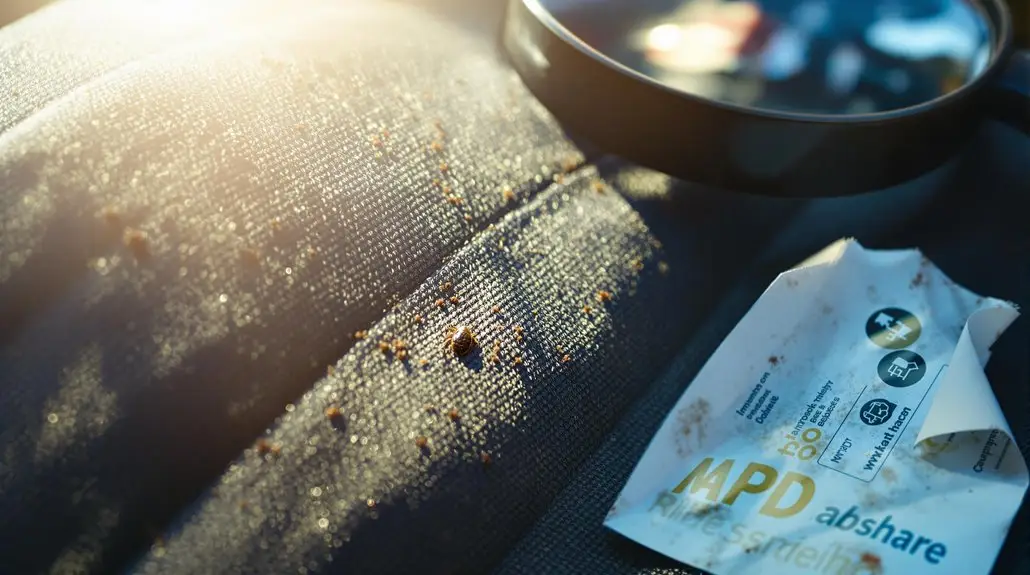
If you suspect bed bugs might be hiding in your vehicle, a thorough inspection is vital. Start by using a flashlight to carefully examine every crack and crevice. Look closely at fabric areas like car seats, floor mats, and rugs, as these are prime hiding spots.
Don’t forget to inspect the seams of the seats and where interior parts come together. To reach tough spots, run a credit card through cracks around the console or glove box. For added confidence, conduct a full-body scan after driving to check for bed bugs on your exposed areas.
Utilize double-sided tape or a lint roller to check crevices; this can help trap any bugs that might be lurking. Equip yourself with the right tools for a more effective inspection. A vacuum with strong suction and a brush attachment can help remove bed bugs and their eggs.
If you have access, a HEPA filter vacuum is ideal for thorough cleaning. For deeper penetration into cracks, consider using a steam cleaner set to over 200 degrees Fahrenheit.
Regular inspections are key, especially if you frequently transport people or items. Keeping your car clutter-free reduces potential hiding spots for bed bugs.
Always inspect items before bringing them into your vehicle to prevent these pests from hitchhiking. Taking these steps guarantees a bug-free ride, giving you peace of mind while you travel.
Signs of Infestation to Watch For
After inspecting your vehicle for potential hiding spots, it’s important to recognize the signs of a bed bug infestation. These pests can disrupt your sense of comfort and security in your own space, so staying vigilant is key. Here are some critical signs to watch for:
- Live Bed Bugs: Spotting live bed bugs crawling on your seats or floor mats is a clear indicator that you need to act fast.
- Dark Spots and Stains: Look for dark stains or rusty spots on fabrics—these marks are often the result of bed bug excrement or crushed bugs.
- Unpleasant Odor: A musty smell in your vehicle can signal the presence of these pests, making your rides less enjoyable.
In addition to these signs, keep an eye out for discarded bed bug skins, tiny whitish eggs, and blood spots on surfaces.
Remember, bed bugs can hide in crevices and seams, making detection challenging. If you notice increased activity during the day, it’s time to take action.
Being aware of these signs not only protects your vehicle but also your home and loved ones from potential infestations. You deserve a space that feels secure and inviting, free from unwanted pests.
If you suspect an infestation, don’t hesitate to seek professional help to reclaim your comfort and peace of mind.
Passenger Precautions and Actions
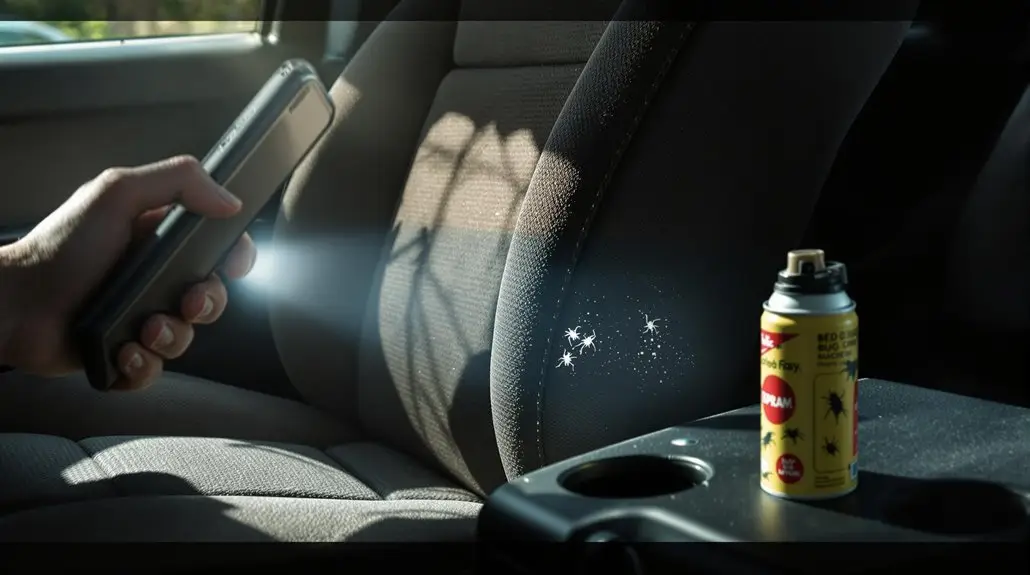
Before hopping into a rideshare, you should inspect the vehicle for any signs of bed bugs.
Make sure to secure your personal belongings to minimize the risk of bringing unwanted pests home.
If you do spot an infestation, report it promptly to help keep everyone protected.
Inspect Before Entering
A thorough inspection of the rideshare vehicle is essential for your security. Before you jump in, take a moment to check for any signs of bed bugs. These pests can hide in various places, so be vigilant.
Here’s what to look for:
- Small insects: Look for apple-seed-sized bugs scuttling around.
- Blood stains or dark spots: These can indicate a previous infestation.
- Shed skins: Golden-colored skins are a telltale sign of bed bugs.
Pay special attention to seams and crevices in the upholstery, as these are common hiding spots. Check between seat cushions and don’t forget the floor and trunk, too.
Remember, bed bugs can be present in both clean and dirty vehicles, so don’t let appearances fool you.
To further protect yourself, sit in the back seat and avoid placing your belongings on the floor. Consider using a flashlight to inspect dark corners.
Secure Personal Belongings
Securing your personal belongings during a rideshare is just as important as inspecting the vehicle for pests. Before you hop in, double-check the driver’s name, photo, and license plate against the app. Make sure the vehicle make and model match the details provided.
Once inside, confirm the driver’s identity by asking for their name, ensuring you feel comfortable right away.
When choosing your pickup and dropoff spots, opt for well-lit and populated areas. Avoid dark or isolated locations that could pose dangers. If you feel uneasy about a pickup point, don’t hesitate to move to a more protected area.
During the ride, keep your belongings close. Sit in the backseat to maintain distance and buckle up for security.
Stay alert—avoid distractions like excessive phone use or dozing off. Use the GPS feature to track your route and communicate trip details with a trusted friend. Sharing your ride status can provide an extra layer of protection.
Report Infestations Promptly
Promptly reporting any signs of bed bugs you encounter during a rideshare can protect not just yourself but also future passengers.
Your actions can create a more secure environment for everyone, fostering a sense of community and care.
If you spot any signs of bed bugs, take these steps:
- Inspect Thoroughly: Check for dark spots, live bugs, or any signs of waste around seats and floor mats. A careful look can reveal hidden issues.
- Take Immediate Action: If you find evidence of bed bugs, clean up or suggest that the driver thoroughly vacuum and shampoo the vehicle.
- Notify Authorities: Inform the rideshare company and the driver about your findings to guarantee they can take the necessary steps to address the issue.
When you step into a rideshare vehicle, it’s wise to be vigilant about preventing bed bugs from hitching a ride with you. These bothersome critters can easily latch onto your belongings if you’re not careful. Here are some practical steps you can take to protect yourself and guarantee a smooth ride.
| Precautions | Actions |
|---|---|
| Inspect Before Entry | Check for signs like red-brown spots or blood stains. Use a flashlight for dark areas. |
| Secure Luggage and Clothing | Place bags on hard surfaces or in the trunk. Keep items in sealed plastic bags. |
| Regular Cleaning and Decluttering | Encourage drivers to vacuum and declutter the vehicle regularly. |
| Post-Trip Precautions | Unpack in the bathroom and wash all clothing in hot water. |
By being proactive, you can help prevent bed bugs from coming along for the ride. Always inspect the vehicle before you enter, watching for any signs of infestation. Secure your belongings properly; sealing your luggage can make a world of difference. Encourage drivers to maintain a clean car, as clutter provides ample hiding spots for these pests.
Lastly, take care when unpacking after your trip. Implementing these strategies not only protects you but also fosters a sense of community awareness about bed bugs in rideshare services. With a little diligence, you can enjoy your rideshare experience without the worry of unwanted guests.
Impact on Passenger Wellbeing

Being vigilant about bed bugs in rideshare vehicles isn’t just about preventing a nuisance; it’s also about protecting your overall wellbeing. The impact of a bed bug infestation can extend beyond mere discomfort, affecting both your physical and mental health.
Consider the following consequences:
- Physical Reactions: Bed bug bites can lead to severe itching and skin reactions. Scratching those bites might even result in secondary infections, adding to your distress.
- Emotional Distress: The anxiety of potential bed bug encounters can keep you up at night, leading to sleeplessness and paranoia. It’s more than just a fear; it can disrupt your daily activities and social life.
- Behavioral Changes: You might find yourself obsessively checking your belongings or avoiding certain places altogether, all in an effort to guarantee you don’t bring these pests home.
The psychological toll of dealing with bed bugs can linger, even after the issue is resolved. Imagine the stress and frustration of constantly worrying about where you might encounter them next.
It doesn’t just affect you; it can impact your loved ones, creating a ripple effect of anxiety and discomfort throughout your circle.
Economic Consequences of Infestations
Bed bug infestations in rideshare vehicles can impose significant economic burdens on both operators and the broader industry.
First off, the cost of extermination is no small matter. Hiring professionals to tackle these troublesome bugs can quickly eat into your budget. If an infested vehicle needs to be taken out of service for treatment, you’ll face lost revenue during that downtime. In severe cases, you might even need to replace upholstery or seats, adding more financial strain.
Insurance may not cover all the costs, leaving you to shoulder unexpected expenses. And if a passenger claims they were bitten, potential lawsuits can bring hefty legal fees and settlements, further complicating your financial landscape.
The impact on reputation can’t be overstated either. Negative reviews spread like wildfire, damaging your credibility and trustworthiness. This deters potential customers and can lead to a decline in your overall revenue. Existing customers may even jump ship to competitors, worried about cleanliness and security.
Operationally, you’ll need to implement regular inspections and staff training to prevent infestations. While this is necessary, it’s resource-intensive and can disrupt your daily operations.
All these factors contribute to an economic ripple effect, not just for you, but for the entire rideshare industry. Increased costs and decreased customer confidence can impact the local economy, especially in areas reliant on rideshare services.
Current Statistics on Bed Bugs
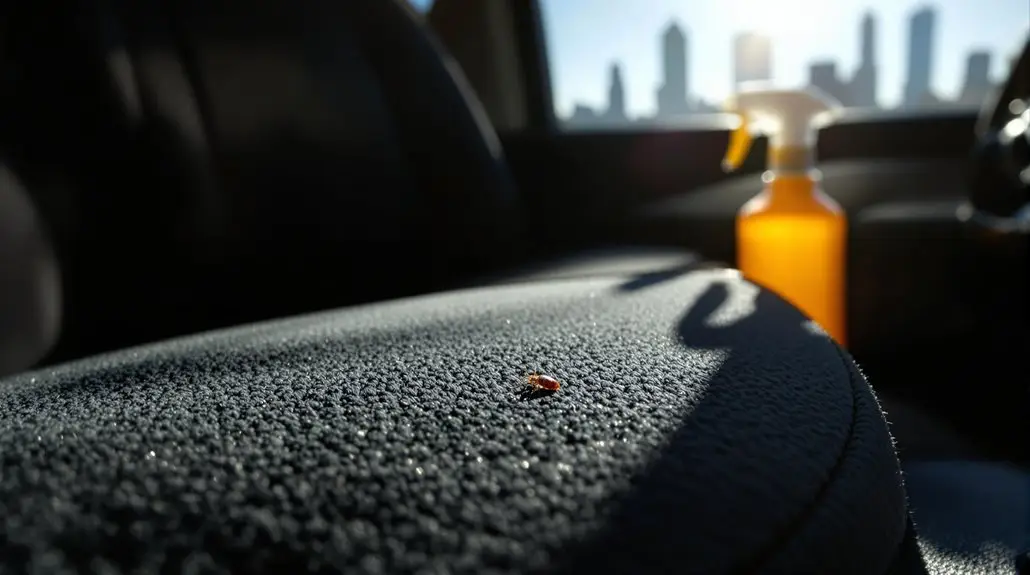
Recent studies reveal a staggering rise in bed bug infestations, indicating that these pests are becoming an increasingly common problem across various environments. As someone who values a protected and cozy space, you’ll want to be aware of the alarming trends surrounding these unwelcome guests.
Consider these statistics:
- 278% Increase: In the last two years, UK hotels have reported a jaw-dropping 278% rise in bed bug instances, making travel a gamble for anyone.
- Top U.S. Cities: Chicago, New York, and Philadelphia are ranked as the top three cities for bed bug infestations in 2024, affecting countless residents and visitors alike.
- Widespread Presence: Bed bugs can be found in hotels, apartments, nursing homes, schools, and even public transportation, meaning they could be lurking just about anywhere you go.
These figures aren’t just numbers; they represent the discomfort and anxiety many people experience. Imagine finding out that a cozy hotel room or a friend’s new couch might be a breeding ground for bed bugs.
It’s enough to make anyone think twice about where they stay or how they manage their belongings. Being informed can help you feel more secure and connected with others who share your concerns about keeping spaces free of these pests.
Frequently Asked Questions
Can Bed Bugs Survive in Cold Temperatures?
Yes, bed bugs can survive in cold temperatures, but they’re not immune to it.
If you expose them to minus 16 degrees Celsius for about 80 hours, it can kill them. They tend to enter a hibernation state when it gets cold, which helps them survive.
How Quickly Can Bed Bugs Reproduce?
Bed bugs can reproduce faster than a rumor spreads! A single female lays up to 25 eggs a week, leading to an explosion of 5,000 bed bugs in just six months.
If you’re not careful, your space could become a bed bug paradise in no time. They hatch in just over a week, so staying vigilant is key.
You wouldn’t want to share your home with these uninvited guests, right?
Are Bed Bugs More Common in Certain Seasons?
Yes, bed bugs are more common in certain seasons, especially during warmer months.
They thrive in heat, leading to increased activity and rapid reproduction. Summer, in particular, sees a spike in bed bug complaints due to heightened travel and higher temperatures.
If you’re traveling, be extra vigilant about inspecting your accommodations and luggage.
Taking simple precautions can help you avoid bringing these pests home and guarantee your space remains comfortable and secure.
Do Bed Bugs Transmit Diseases to Humans?
Bed bugs don’t transmit diseases to humans, so you can breathe a little easier. Their bites might cause itching or allergic reactions, but there’s no scientific evidence linking them to disease transmission.
You should be aware, though, that scratching can lead to secondary infections. Staying informed and taking preventive measures will help you avoid the discomfort and anxiety that can come from a bed bug infestation.
Your peace of mind matters!
Can DIY Treatments Effectively Eliminate Bed Bugs?
Can DIY treatments really eliminate bed bugs effectively?
While you might think spraying low-toxicity solutions or using diatomaceous earth will solve your problem, these methods often fall short. They only tackle surface bugs, leaving hidden populations to breed.
Instead of risking your peace of mind with unreliable fixes, consider an all-encompassing approach that includes professional help.
You’ll find that investing in expert pest control can ultimately save you time and frustration.
In the world of rideshare, staying vigilant against bed bugs isn’t just smart—it’s crucial. Like a hidden thief in the night, these pests can invade your car without warning, impacting both drivers and passengers. By adopting proactive cleaning habits and being aware of the signs of an infestation, you can protect your vehicle and guarantee a comfortable ride.
At NaturePest Holistic Pest Control, we understand the importance of maintaining a clean and pest-free environment. Our eco-friendly solutions ensure that your car remains a sanctuary for everyone who climbs in. Don’t wait for an infestation to strike—take action today! Contact NaturePest for expert advice and effective treatments to safeguard your rideshare vehicle from bed bugs. Remember, a clean car is not just a haven for you—it’s a sanctuary for all your passengers.

